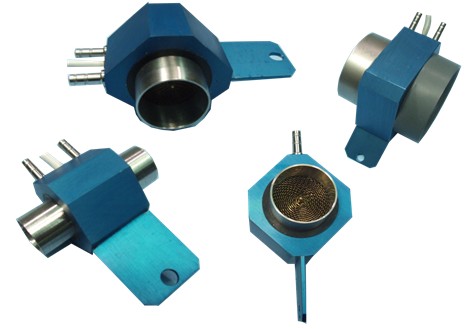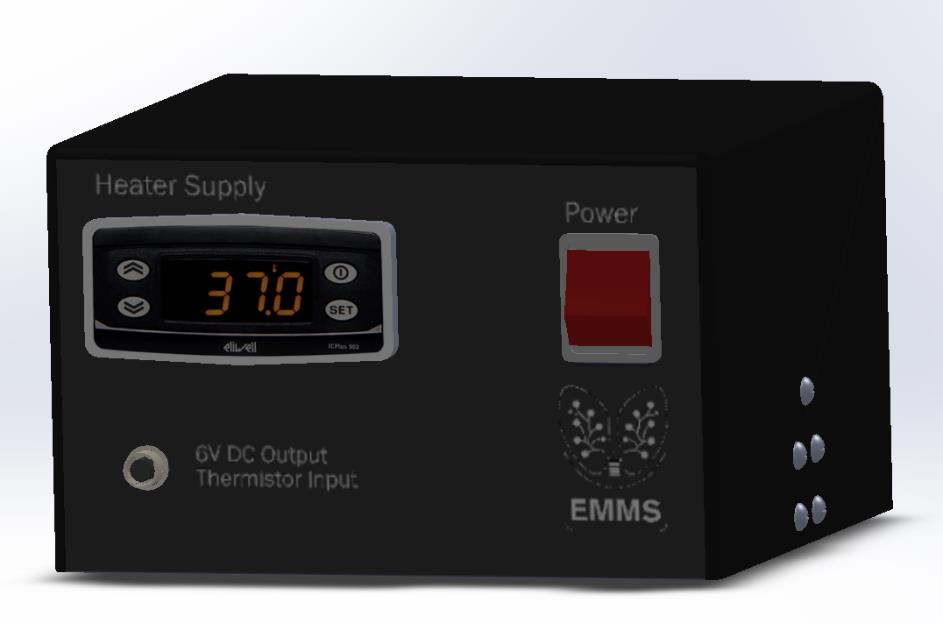Description
A Fleisch Pneumotachograph is based on the principle of Poiseuille’s Law, which states that, assuming laminar flow in a narrow tube, flow is proportional to the pressure drop per unit length of the tube. A continuous measurement of this pressure drop (the difference in pressure between two points in the tube), provides a differential relationship between pressure and flow. Hence the device can be used to measure respiratory flow in-line with the airway.
In the Fleisch pneumotachograph, laminar flow is achieved by distributing the air flow into a large number of narrow, parallel tubes.

Advantages
Robust Design and Construction without Moving Parts.
Linear and Accurate on the measuring range
Includes integrated Thermistor to heat the unit and reduce condensation
Can be provided with Certificate of Calibration
Optional Temperature Controller with digital display for precise control of the temperature
Applications
These devices can be placed in line with the airway of an animal to monitor respiratory parameters. Depending on the application it can be connected directly to an intubated or tracheostomized animal, or adapted to a tight-fitting mask.
It can also be combined with a trans-pulmonary pressure measurement (using an oesophageal water-filled cannula) to compute additional parameters such as resistance and compliance.
It can also be used for industrial applications to monitor constant or variable flows.
Here is a list of the main parameters that can be obtained when connected to a respiratory flow:
| Name | Units | Description |
|---|---|---|
| TV | ml | Tidal Volume, volume inspired during one breath |
| tI | s | Inspiration time |
| tE | s | Expiration time |
| PIf | mls/s | Peak inspiratory flow |
| PEf | mls/s | Peak expiratory flow |
| f | breaths/minute | Frequency of breathing |
| MV | ml | Minute Volume, volume inspired in one minute |
| tR | s | Relaxation time |
| AV | ml | Accumulated volume |
| EIP | s | End inspiratory pause |
| EEP | s | End expiratory pause |
| VolBal | % | Difference between inspiratory/expiratory volume |
| EF50 | ml/s | Expiratory flow @ 50% TV |
Specifications
To measure the flow, a differential pressure transducer is used to record the pressure drop as air passes through the tube. With the appropriate calibration, and when connected to a computer, the signal can be analysed to obtain accurate data.
The units are fitted with a thermistor. When connected to the optional heater controller they are kept at a constant temperature (user-programable). This helps to reduce the condensation in the unit generated by the exhaled air from the subjects.
Below is a list of the different sizes offered:
| Reference | Size | Max Flow | Species |
|---|---|---|---|
| PNM 050 | 00000 | 12 ml/s | Mouse |
| PNM 040 | 0000 | 20 ml/s | Rat, Guinea Pig |
| PNM 030 | 000 | 60 ml/s | Guinea Pig, Rabbit |
| PNM 020 | 00 | 150 ml/s | Small primate, Cat |
| PNM 010 | 0 | 350 ml/s | Cat |
| PNM 100 | 1 | 1.2 l/s | Dog |
| PNM 200 | 2 | 3 l/s | Pig |
| PNM 300 | 3 | 8 l/s | Pony |
| PNM 400 | 4 | 14 l/s | Horse |
| PNM 500 | 5 | 25 l/s | Horse Exercising |
Images
Selected References
Experimental respiratory Marburg virus haemorrhagic fever infection in the common marmoset (Callithrix jacchus)
Sophie J. Smither, Michelle Nelson, Lin Eastaugh, Thomas R. Laws, Christopher Taylor, Simon A. Smith, Francisco J. Salguero and Mark S. Lever
Bioavailability and Efficacy of Levofloxacin against Francisella tularensis in the Common Marmoset (Callithrix jacchus)
Michelle Nelson, Mark S. Lever, Rachel E. Dean, Peter C. Pearce, Daniel J. Stevens, and Andrew J. H. Simpson



